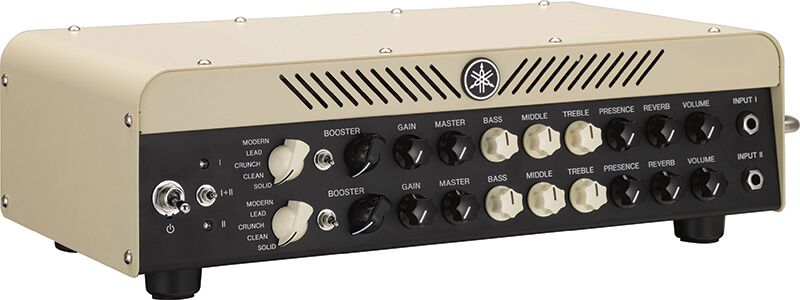Performer reviews the Yamaha THR100HD Modeling Guitar Amp Head
Yamaha makes pretty much EVERYTHING — pianos, guitars, motorcycles, and are known for their high quality. Their THR100HD guitar head lives up to their reputation of a well thought out piece of engineering that has everything a working guitarist would want.
Its metal chassis is quite small, but just big enough to sit on top of a standard 1×12 cabinet. With 2 “channels” of the usual controls: Gain, Master, Bass, Middle, Treble, Presence, Reverb, and Volume. A boost control is also available on each channel, as is an amp selector that allows the player to dial in the characteristics of popular amp styles:
- Solid: a solid-state amp model. It’s kind of reminiscent of an old Polytone
- Clean: very traditional American (Fender) tone
- Crunch: Think Vox AC style
- Lead: Classic Marshall-ish, very British
- Modern: Sits somewhere in the Bogner/Boogie realm

While this is a solid-state amp, there are some interesting tonal tweaks available; each channel can be tailored to have the power amp response of EL34, 6L6 KT88, EL84 or 6V6 tubes, and work as a Class A or Class A/B amp. Class A responds a lot more to guitar input levels, and Class AB operates with a lot clearer output overall.
All these features aside, each amp model delivers fantastically. The Clean channel can be overdriven like a classic tweed or blackface, and the Crunch can do early British Invasion to saturated Brian May-style velvety goodness. But the real deal is the fact with the EQ, power amp selection controls and Boost, it can take the flavor of the amp it’s styled after and give it that little extra. Ever wonder what an AC30 sounded like with KT88’s, or do you favor a Marshall with 6L6’s? That little extra that usually makes a player wish for an amp mod, or meant adding a booster or external device, is built in here. A Polytone with an EQ that is actually versatile?!?!? Part of an amp’s quality isn’t the sound, but the player’s reaction and interaction which really is the dividing line. The amp responds like the versions available, and goes even further.
It responds well to pedals too, but this amp could stop an overdrive pedal junkie in their tracks. There is an effects loop of course, and included is a well-thought-out footswitch control. The head comes equipped with XLR outputs for direct recording or PA applications, plus a USB connection for editing through Yamaha’s software utility app, or direct recording to a computer. A headphone connection is also available for personal practice.
Now here’s the game changer: remember how I put channels in quotations? Think of each channel as two separate amps. There is the option to run BOTH channels at the same time, blending the two tones in parallel. Run the crunch of a Vox, but get the tight low-end from the higher-gain modern channel, no problem. There may be a bit of fiddling of getting the right balance, but it’s well worth it. Take it a step further and run the head to two separate speaker cabinets, and one cab will go to “channel 1” and the other to “channel 2.” For players who use two amps at the same time, this amp can make your life a lot easier, without sacrificing tone. In the studio using this feature via USB connection can bring great tones, without a ton of external adjustments or having to tax a CPU with plug-ins.
The only downside is that getting the balance of tones between the channels requires a bit of tweaking, with no master volume for both channels at the same time, so taking a bit more time at sound check isn’t a bad idea. The controls sit inside the chassis, with the exception of the power switch, which sits a bit proud outside of the unit. There’s a slight fear that it could get sheared off. A lower profile switch would be a bit better. But these two negatives are very minimal considering that this amp offers up great sounding versions of the modeling choices offered, and a plethora of tonal adjustments that go beyond what you may think of as coming from a modeling amp.
Players who bring two tube amps to a gig, this amp is looking at you! It gives great tonal options, without the maintenance of tubes, in an ultra-portable chassis.
PROS:
Great amp selection, great way of blending the channels, footswitch included.
CONS:
A bit of adjusting overall volume blending, slightly large power switch.
